We collect a rich harvest, observing the rules of care - tomato "Liana" and the method of its cultivation
Liana's tomato, bred in Transnistria and entered in the State Register in 1996, is unpretentious in its care, so both beginners and experienced gardeners can grow it. Early maturity, high yield, the ability to grow in different regions of the country and the excellent taste of the fruit make the variety popular among gardeners.
The content of the article
Characteristics and description of the variety
Liana - determinant early ripe tomato for open ground, film shelters or greenhouses. Despite the fact that the variety was bred in Moldova, it was zoned for the Central region, the Urals and Siberia. It is successfully cultivated in the south of the Russian Federation.
Bushes are compact, up to 50 cm high, densely leafy. Leaves are dark green in color, slightly corrugated. Despite its small size, the variety needs support due to the large weight of the tomato brushes.
Flowering begins 70–90 days after the first shoots, and after 85–100 days the crop is harvested. The lower inflorescences are above 5-6 leaves, and all subsequent ones - after 1-2 leaves.
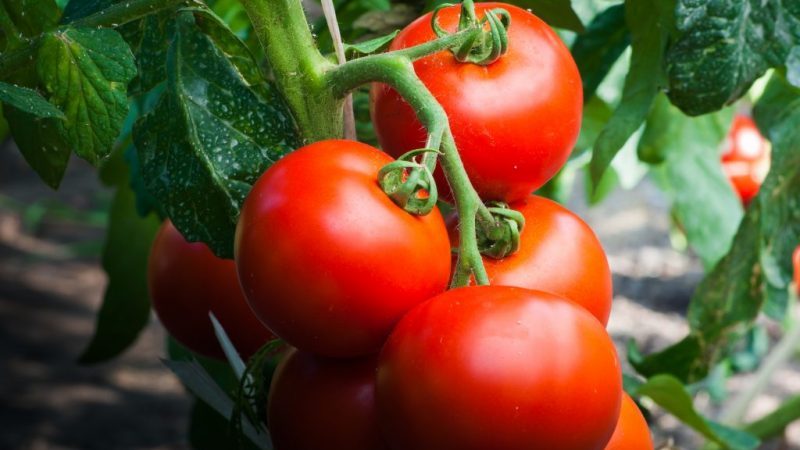
Distinctive features
There are two varieties of Liana: pink and red. Pink fruits are rare among early tomato varieties. Such fruits literally melt in your mouth.
The variety is early maturing and high-yielding. It is resistant to temperature extremes and is able to form fruits in cold summer conditions.
Fruit characteristics and yield
Fruits are round in shape with a smooth thin skin. The average weight of each is 50–80 g. Tomatoes have low acidity, the dry matter content does not exceed 6%. Contains carotene, vitamins C and B. Tasters from the State Variety Testing Commission gave Liana the highest rating in terms of taste.
For reference. In private farms, 10-15 kg of fruits are harvested from 1 m2, and 2-3 kg from one bush.
How to grow seedlings
Tomatoes are sometimes grown by direct seeding into the ground, but the seedling method would be a better solution for most regions of the country.
Seed preparation
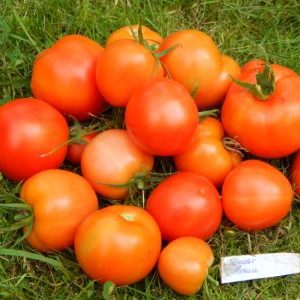
Seeds remain viable for several years, but stronger seedlings are obtained from fresh specimens... Before planting, the material is inspected, small and damaged grains are thrown away. For better germination, the seeds are soaked for 8-15 hours in Energena solution (15 drops per 50 ml of water).
Then they are dipped for 30 minutes in a strong solution of potassium permanganate for disinfection. Then they are washed and put in a refrigerator for hardening for 1 day.
Capacity and soil
Various containers are used for seedlings: special trays with cups purchased at the store, disposable plastic cups, milk packaging. Most importantly, there is sufficient soil for root development and drainage holes to drain excess moisture.
In the store, they buy special soil for tomatoes or prepare it themselves from:
- garden or sod land - 50%;
- humus - 25%;
- sand - 25%.
The mixture is thoroughly mixed, add 0.5 l of ash.
Any soil is disinfected by heating in an oven at +100 ° C (30 minutes) or steaming in a colander over boiling water (20 minutes).
Sowing
Optimal sowing dates for seedlings: March 20 - April 10. Disembarkation is carried out in one common tray.
Seeds are spread to a depth of 0.5-1 cm, at a sufficient distance from each other. Cover with glass or plastic wrap from above.The container itself is placed in a warm, bright place.
Growing and care
The first shoots appear in 4-6 days. The film is immediately removed, and the air temperature is lowered so that the seedlings do not stretch. When real leaves appear, the plants dive into separate cups. Seedling care is reduced to regular watering and fertilizing every 2 weeks with mineral fertilizers.
1-2 weeks before planting the bushes in the ground, they begin to harden to improve adaptation to new conditions. Seedlings are taken out to the balcony or greenhouse, first for several hours, gradually increasing the time to a whole day.
reference! The ready-to-plant crop has dark green foliage and a purple underside of the stem.
How to grow tomatoes
To obtain a bountiful harvest, it is important to observe the peculiarities of caring for the variety.
Landing
Tomatoes are planted in open ground or in a greenhouse when the soil temperature rises above + 16 ° C. At low rates, the root system of tomatoes will not develop.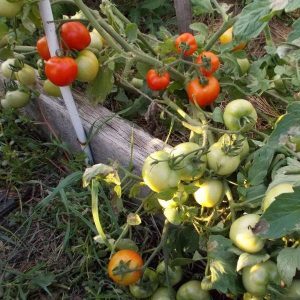
The beds are prepared in advance: a bucket of humus is added per 1 m2, 1 tbsp. ash, 30 g of potassium sulfate, 50 g of superphosphate. In the fall, the earth is dug up, weeds are removed.
Fertilizers are added directly to the wells: 0.5 kg of humus, 1 tbsp. l. ash, 1 tsp. potassium sulfate, 1 tsp. superphosphate. Before planting, the plants are well watered and the lower weak leaves are cut off.
Liang's tomato belongs to undersized varieties, so its planting pattern is 30–40 cm between bushes and 60 cm between rows. After placing the seedlings in the holes, they are watered abundantly with warm water. After that, watering is stopped for 7-10 days so that the plant develops a root system. Tomatoes are tied up so that the lower leaves do not touch the ground.
Care
Caring for Lyanoy is usual for low-growing varieties: regular loosening, weeding from weeds, watering and feeding. The plant is prone to bushiness, so they choose the 2 strongest shoots, and the rest stepsons removed.
Watering is carried out rarely, but abundantly, soaking the soil up to 50 cm in depth. Depending on the air temperature, the soil is moistened 1-2 times a week. In August, the amount of watering is reduced.
Throughout the growing season, tomatoes need dressing... Before flowering, they are fertilized with a complex mineral composition, an infusion of chicken droppings or slurry. During the flowering period, they are sprayed with boric acid. When pouring, the fruits are fed with fertilizers containing phosphorus: superphosphate or potassium monophosphate, diluted in water according to the instructions.
Features of cultivation and possible difficulties
Tomatoes are not planted after peppers, eggplants, potatoes. They belong to the nightshade family, so they are prone to being affected by the same diseases. The best precursors for tomatoes: carrots, cabbage, cucumbers, legumes, garlic.
For the strength of the culture, it is formed into 2-3 stems. The variety has a rather dense foliage, so some of it is cut off so that the fruits ripen better.
Lyana is a high-yielding variety with a friendly return of fruits. The plants are tied up, otherwise the stems will not withstand the weight of the vegetables and will break off.
Diseases and pests
The tomato is genetically immune to top rot and bacterial blight. It has a tendency to a viral disease - tobacco mosaic, when variegated and dark spots appear on the stem and leaves, after which the plant dies. Causes of the disease: high humidity, lack of light and an excess of nitrogen in the soil.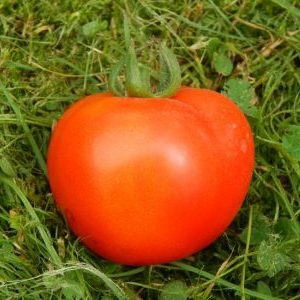
The stems of infected plants are cut off, the cuts are disinfected with a solution of potassium permanganate or hydrogen peroxide. At the initial stage, the bushes are treated with a solution of karbofos: 75 g of pesticide is taken for 10 liters. Tomatoes are sprayed every 2 weeks.
Preventive treatment against late blight is carried out with low-toxic drugs ("Fitosporin", "Phenomenon", "Allirin") 2 weeks after planting and continue throughout the season, at intervals of 2 weeks.
Crop pests - whitefly, Colorado potato beetle, bear, spider mite:
- Whitefly - a butterfly measuring 0.5 cm.Its larvae gnaw leaves and carry viral diseases. Spraying with "Fitoferm" and watering under the root of the insecticide "Aktara" help against the insect.
- From the Colorado potato beetle and its larvae plants will be protected by the treatment of bushes with Aktara, Iskra, Inta-vir.
- If a bear starts up on the site, "Medvetox" and "Grizzly" granules are placed in the soil.
- Spider mite control - spraying of bushes with "Fitoferm" and acaricidal preparations.
The nuances of growing in an open field and a greenhouse
The variety grows equally well both outdoors and indoors. If tomatoes are planted in a greenhouse from May 5-10 (depending on weather conditions), then in open ground - at the end of May - beginning of June, when the danger of recurrent frosts has passed.
In the beds, the height of the plants is slightly lower than in the greenhouse (40–45 cm versus 60 cm and more).
The variety grows to a certain height, and the upper shoot ends in a brush. Leaving the lateral stepson at the top of the plant, the tomato can continue to grow. This is done when growing crops in greenhouses.
Attention! In a greenhouse, the yield from a bush will be higher, but if the summer is hot and the tomatoes are ripe in the open field, then they will have a sweet aromatic pulp.
Harvesting and application of the crop
Liana is early ripening: the first ripe fruits are harvested at the end of July... Sometimes there are so many vegetables on the plant that some of them are removed green so that the bush does not break. Harvesting continues throughout August until the onset of cold nights. The variety has time to completely give up its harvest before frost.
Thanks to their thin skin and juicy pulp, tomatoes are good for fresh consumption. They are small in size, and therefore versatile in preparation: suitable for canning for the winter (pickling, pickling), mashed potatoes, sauces and adjika.
Kept fresh for up to 3 months at a temperature of + 8 ... + 10 ° C.
Advantages and disadvantages of the variety
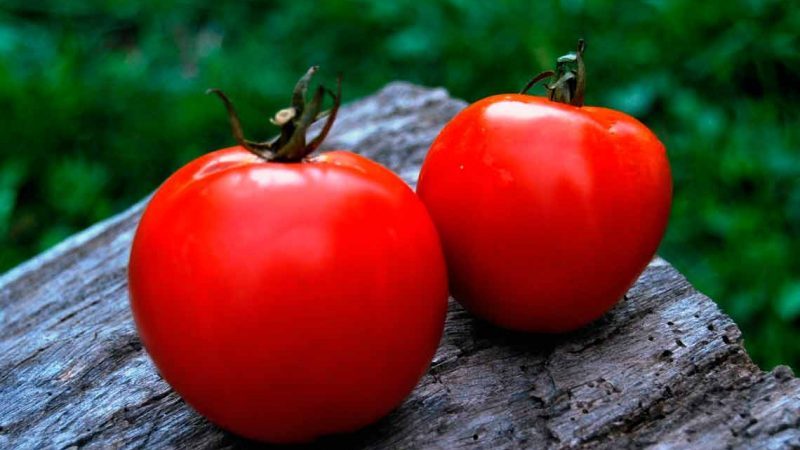
The advantages include:
- unpretentious care;
- early ripening of fruits;
- great taste;
- long shelf life and high transportability;
- presentation of fruits;
- versatility in application;
- extended fruiting.
Disadvantages - susceptibility to the tobacco mosaic virus and excessive leafiness of the bushes.
Farmers reviews
Positive feedback from farmers about Liang's tomato indicates that the variety is suitable for cultivation both for personal purposes and for sale.
Sergey, Voronezh: “Tomato Liang supplies the family with a large harvest, the surplus is easily transported without any damage to the fruit to the nearest market. Tomatoes do not lose their appearance during storage. "
Alexey, Volgograd: “Whoever has tried to plant Liang at least once knows that these tomatoes grow without problems, do not require hassle and time consuming. As a result, the yield is higher than expected. "
Alena, Donetsk: “Lyana is hardy, so she always helps out in case of crop failure in other varieties of culture. The presentation, as in the photo, and the taste of the fruit deserve only the highest marks. "
Conclusion
Due to its qualities, Liang's tomato has earned the recognition of vegetable growers. It is an unpretentious variety with a high yield (10-15 kg per 1 m2), undemanding to weather conditions, drought-resistant, with early ripening of fruits. The excellent taste of tomatoes and high transportability make the culture in demand and popular.